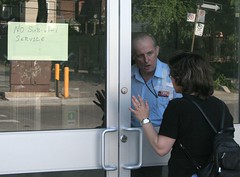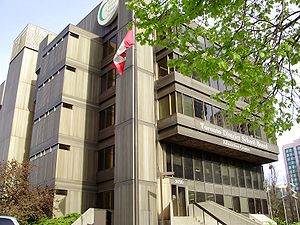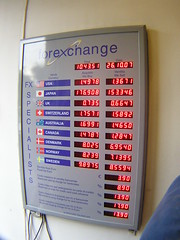The Toronto Transit Commission (TTC) announced earlier this month they were going to raise fares by a quarter. These fare increases are nothing new, Canada’s largest public transit system continually is ignored by all three levels of government.
The fare increase of a mere quarter may not seem like much to those of us sitting in our luxury SUVs,
 Image by TransferPoint via Flickr
Image by TransferPoint via Flickr
For most of those regular riders, the TTC is their only method of travel, so they depend on the service to do life’s basic necessities – such as going to the grocery store to buy food, going the drugstore to get much needed medicines, and going to work to earn an income to pay for it all.
But, in a boneheaded move which still has many of Toronto’s transit riders – and even some of us who don’t take the service – shaking our heads in bewilderment, the TTC has made it almost impossible for many riders to take the service, all in attempt to prevent lost fare revenues.
Just prior to fare increases, the metal tokens passengers use to pay for the service normally sold in abundant supplies are limited. This is done to prevent hoarding of tokens, so that those taking the service don’t stock up at the old price.
But this year, the TTC announced they weren’t selling tokens at all, until the new higher fare took effect in the New Year. Instead, they’d be issuing temporary tickets which would become invalid immediately in January.
Problem though, some TTC riders were left stranded where they
 Image by TransferPoint via Flickr
Image by TransferPoint via Flickr
So, if you happened to be within walking distance of a subway station, no problem, you could make the hike to get these new tickets – which incidentally were introduced in a period of less than 24-hours, even the media didn’t know about this new scheme until the night before. But if you weren’t within walking distance of one of the 69 subway stations, you were out of luck.
The TTC’s excuse? It estimates it could lose about $13 million in fare revenues by people buying tokens in bulk prior to the fare increase, so they cut off the token supply. But in so doing, they also cut off access to the system for their riders – which in effect would cost them fare revenues because people couldn’t get onto the system.
Usually tickets are sold without any limits, because newer tickets are printed when the new higher fare takes effect, so collectors and drivers can tell when someone is attempting to use an older, outdated ticket. The tokens on the other hand, are continually re-used.
But in past years, to beat the fare increases, or even to ride for free, some creative-types were able to duplicate the paper tickets, essentially creating their own exact copies.
 Image by Canon Fodder XT via Flickr
Image by Canon Fodder XT via Flickr
So, earlier this year, the TTC stopped selling tickets altogether, only issuing either tokens or passes. This only compounds the problems once the TTC stopped selling tokens – which was a really bad idea period.
Who’s brain-dead idea was it to suddenly, and without any warning, stop selling the primary payment method most of the over 460 million annual riders use to take the transit service? That’s like your bank suddenly telling you they no longer accept cash.
As per usual with Canada’s largest transit system, time will pass and eventually cooler heads will prevail, as people forget the current fiasco. Though if the suits and ties that drive to their offices in their own personal vehicles, instead of taking the actual service they manage, actually cared about the service they provide – or in this case failed to provide – heads would roll.
In any other company, a marketing, public relations and customer service blunder as big as this would cost those responsible for the mess their jobs.
Not Canada’s largest transit system – it just plows on through as if nothing went wrong. And that perhaps is even worse than the mistake in the first place. We all make mistakes, but the TTC’s top brass is too arrogant to own up to their mistakes.
Not that they didn’t learn anything from this whole mess – but learning from one’s mistakes is only part of the resolution. One also has to be willing to take ownership and acceptance of the initial mistake to make a real difference in the lives of those affected.
![Reblog this post [with Zemanta]](http://img.zemanta.com/reblog_b.png?x-id=0973f356-0d6f-45fc-9594-6164e68bac43)



![Reblog this post [with Zemanta]](http://img.zemanta.com/reblog_b.png?x-id=c5167378-db1e-4e2c-adfd-01ce1562c2e7)



![Reblog this post [with Zemanta]](http://img.zemanta.com/reblog_b.png?x-id=7a696c99-3aa8-4961-bdd8-693bd7da4166)



![Reblog this post [with Zemanta]](http://img.zemanta.com/reblog_b.png?x-id=76561a26-04d5-4475-9cdc-76b0b31825f2)



![Reblog this post [with Zemanta]](http://img.zemanta.com/reblog_b.png?x-id=cf9fdb69-6eb7-4505-a4d7-c93117c11a84)



![Reblog this post [with Zemanta]](http://img.zemanta.com/reblog_b.png?x-id=524cef96-f960-40d5-aca1-5cec57a89963)



![Reblog this post [with Zemanta]](http://img.zemanta.com/reblog_b.png?x-id=2b827c2e-1387-447c-87e9-f898817ae7a1)



![Reblog this post [with Zemanta]](http://img.zemanta.com/reblog_b.png?x-id=fe0a2a5a-2acb-4dc0-9ca3-e67fd9617103)




![Reblog this post [with Zemanta]](http://img.zemanta.com/reblog_b.png?x-id=2fd563a2-6f21-46b4-aeff-45f372ddc0ac)







